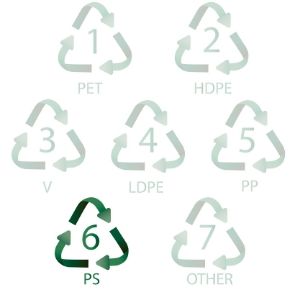Trust your plastics recycling questions to. Casings for electronics -.
Hard-to-recycle plastics including Styrofoam shrink wrap and manufacturing scrap require specialized handling.

Number 6 plastic recycling. The presence on an item of a recycling code a chasing arrows logo or a resin code is not an automatic indicator that a material is recyclable. If you cant find any local takers on earth911 you can mail your 5 to a recycler called Preserve which has an aptly named program called Gimme 5. These codes were developed by the Society of the Plastics Industry SPI in 1988 to provide an industry-wide standard that would make it easier to identify and sort recyclable plastic.
While 1 and 2 plastics are almost universally recyclable at any recycling facility 3 and up are more challenging. This plastic recycling number is often seen on food containers for carry-out items as well as meat trays for meats packaged at a grocery store. Codes have been developed for batteries biomatterorganic material.
Once overseas they are either sorted out further melted down into a 7 other plastic or burned as fuel. Insulation light switch plates egg cartons vents rulers foam packing carry-out containers Polystyrene can be made into rigid or foam products -- in the latter case it. Number 6 plastics can be recycled through some curbside programs.
6 plastic is cheap to produce lightweight and it can be easily formed. Curbside recycling programs usually dont allow polystyrene because its difficult to manage. You may not know Polystyrene or plastic no 6 can be recycled.
This is one of the plastic recycling codes that must be avoided or at least reused as it is hard to recycle 6 plastic. It is an explanation of what the item is made of. Types 1 and 2 plastics may be tossed into standard recycling bins.
Plastic 6 also known as polystyrene or PS can be found in both a hard brittle form or. Number 7 plastics are denoted by the letter O or the word OTHER. 6 Better known as polystyrene or Styrofoam No.
Recycling codes are used to identify the material from which an item is made to facilitate easier recycling or other reprocessing. It advises what type of plastic the item is made from but not if it is recyclable. We meet it in the form of rigid polystyrene and formed styrofoam.
Recycling different plastic types. Number 6 plastics are indicated by the letters PS which stands for polystyrene. The number to found on the bottom of plastics is not a recycling symbol but rather a plastic or resin identification code.
Its hard to separate polystyrene at the facility as it can contaminate other recycling materials. 6 plastics are found in disposable plates and cups meat trays egg cartons carry. They are accepted by some curbside recycling programs.
Other plastic types may not be permitted in your bin depending on your municipalitys guidelines. In general higher numbers equal plastics that are tougher to recycle. Resin codes are indicated by the small number enclosed by the chasing arrows symbol on the bottom of many plastics.
It cant be recycled in your recycling bin but there are specialist recyclers who will take it. PS PS polystyrene can be made into rigid or foam products in the latter case it is popularly known as the trademark Styrofoam. Number 6 plastic stands for polystyrene PS or styrofoam.
At the Material Recovery Facility or recycling center 6 plastics are often sorted out sometimes with other low-value plastics and sent overseas. Yes number 6 plastic IS recyclable but it is more difficult to recycle than other plastics and not as many recycling centers accept it. What recycled plastic 6 becomes Recycling PS plastics is less common than some other types but when it is recycled it can be made into a whole range of new products.
6 PSPolystyrene is the foam plastic used for packing materials Styrofoam cups trays etc. 6 Plastic Recycling Symbol 6. Most hard plastics coded 1-7 can be recycled in your yellow lidded recycling bin.
Plastics with a higher number inside the little recycling triangle symbol are more likely suited for the trash. Many small plastic items like most plastic utensils are made from polystyrene.

